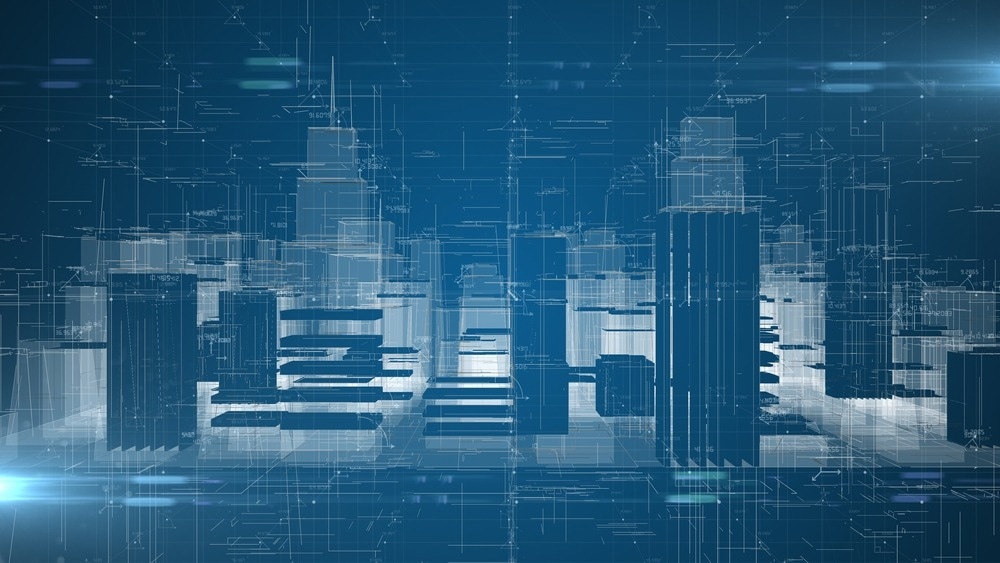The Internet of Things (IoT) is a technology concept that puts “smart” functionality – computer processing and wireless connectivity – into objects so that they can be monitored and read by machines. In construction, IoT enables automation and makes projects more efficient, better managed, and less wasteful.

Image Credit: Immersion Imagery/Shutterstock.com
The world population is growing, and at the same time, a large proportion of it is moving into cities. A direct result of these trends in global population and urbanization is a rising demand for construction: more people in cities (and more people in general) means more homes, workplaces, roads, schools, hospitals, and so on.
The construction industry already accounts for over 13% of the world’s entire GDP and contributes a similar proportion of the world’s carbon dioxide emissions. This means that making construction more efficient as a whole has a large and direct impact on both the global economy and the planet’s environmental health.
This is where IoT, or IIoT (Industrial IoT) can come in. While the construction sector is typically conservative and slow to adopt new technologies, the concurrent pressures of increased demand for construction and the environmental need to minimize waste mean that project managers have to keep finding more efficient ways of building.
And they are turning to IoT, automation, and artificial intelligence (AI) for help.
With IoT, developers can synchronize all of their assets – equipment, materials, and the workforce – with a central server that can monitor and manage all construction activities in real-time. This provides a global perspective of projects, programs, and even the entire firm’s dynamic set of assets.
A new construction tech sector is emerging to meet these needs. Companies like ES Track, Pillar Technologies, Trimble, and others are developing construction-specific IoT technology for the major players in the sector today.
A recent survey by the global business services corporation, KPMG, found that 95% of construction firms expect IoT and new technologies like it to significantly alter their industry in the next few years. In the same survey, nearly three-quarters of construction businesses said that adopting new technology such as IoT is a key part of their forward strategy.
Another survey, conducted by rival business services firm PwC, found that nearly all industrial companies and organizations (98%) believe that digital solutions including predictive maintenance that relies on IoT can provide a 12% increase in efficiency for adopters.
Construction cannot be an exception, and some analysts predict that firms that do not adopt new technologies soon will find themselves left behind.
How IoT Enables Building Automation
IoT and automation go hand in hand. Automated construction processes like predictive maintenance only work when there is a lot of passive data collection taking place across the building stock. Automation needs the large datasets that only IoT is capable of providing.
A key feature of IoT in construction is Building Information Modeling (BIM) technology. BIM processes create a digital twin for entire building projects. A BIM model can be considered a kind of 4D or even 5D version of computer-aided design (CAD) plans.
One of the extra dimensions is time, with BIM models showing how the project will develop to complete construction and beyond its service life. The other extra dimension is information, as BIM models include data like load stresses, deterioration and maintenance processes, or different stakeholders’ needs.
With IoT, all of this data can also be live. That means the BIM model is a dynamic digital twin, changing automatically to reflect changes in the real world. The flow of real-world data that IoT provides enables all stakeholders to manage construction projects – and to manage buildings in their service life – as efficiently as possible, reducing the need for in-person inspection and predicting faults before they arise with the power of AI.
In construction processes, equipment, and workforces, IoT is also helping project managers to maximize efficiency. IoT solutions already widely used in logistics help construction firms to keep constant track of their assets, which in turn enable them to accurately pinpoint pain points and inefficiencies in their processes.
IoT can also help to improve worker safety. Construction workers using wearables (IoT devices that you wear) have their vital signs monitored automatically as well as their immediate working environment. These systems automatically keep workers safe by alerting them to dangers including overheating and fatigue.
Examples of IoT for Construction
There are a number of IoT devices available for construction projects.
Popular wearables for the workforce include the Hololens, which gives workers a 3D plan of the property with augmented reality (AR), and Smart Cap, a brain wave tracker that monitors fatigue.
Hyundai Construction Equipment and Remote Eye are examples of site monitoring systems. The former allows project managers to check a 360-degree view from any angle in the machine it is attached to.
Brimba and VibrAlign are predictive maintenance systems that use IoT to automate maintenance scheduling for maximum safety and minimum unnecessary resource use.
More from AZoBuild: Do Fluid Viscous Dampers Between Adjacent Buildings Work Safely?
References and Further Reading
How IoT Can Improve the Construction Industry. (2020) [Online] Digiteum. Available at: https://www.digiteum.com/iot-construction-industry/
IoT in Construction Industry: Future, Use Cases, Challenges, and Benefits. (2020) [Online] European Business Review. Available at: https://www.europeanbusinessreview.com/iot-in-construction-industry-future-use-cases-challenges-and-benefits/
Disclaimer: The views expressed here are those of the author expressed in their private capacity and do not necessarily represent the views of AZoM.com Limited T/A AZoNetwork the owner and operator of this website. This disclaimer forms part of the Terms and conditions of use of this website.